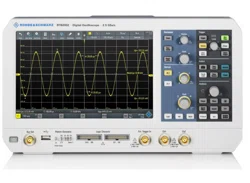Loading ...
Loading ...
Loading ...

Waveform Setup
R&S
®
RTB2000
42User Manual 1333.1611.02 ─ 03
Remote command:
CHANnel<m>:POLarity on page 255
Vertical Scale
Sets the vertical scale in Volts per division to change the displayed amplitude of the
selected waveform. The current value is shown in the waveform label below the grid.
Vertical scale directly affects the resolution of the waveform amplitude. To get the full
resolution of the ADC, set up the waveforms to cover most of the height of the dia-
gram.
Remote command:
CHANnel<m>:SCALe on page 253
Offset
The offset voltage is used to correct an offset-affected signal. The vertical center of the
selected channel is shifted by the offset value and the signal is repositioned within the
diagram area. To set the offset automatically, use Autoset.
Use the offset to measure small AC voltages that are overlaid by higher DC voltages.
Unlike AC coupling, the DC part of the signal is not lost with offset setting.
Remote command:
CHANnel<m>:OFFSet on page 254
Deskew
Sets a time delay for the selected channel.
Deskew compensates delay differences between channels caused by the different
length of cables, probes, and other sources. Correct deskew values are important for
accurate triggering. Signals that are routed over lines with different lengths have a dif-
ferent propagation delay. This delay may lead to a non-synchronous waveform display.
For example, a coax cable with a length of 1 meter has a propagation delay of typically
5.3 ns.
Remote command:
CHANnel<m>:SKEW on page 255
Zero Offset
Differences in DUT and oscilloscope ground levels can cause larger zero errors, which
affect the waveform. If the DUT is ground-referenced, the "Zero Offset" corrects the
zero error and sets the probe to the zero level.
You can assess the zero error by measuring the mean value of a signal that returns
zero.
Remote command:
CHANnel<m>:ZOFFset[:VALue] on page 255
Waveform Color
Selects the color scale for the display of the waveform. Each scale comprises a set of
colors, where each color represents a certain frequency of occurrence.
"Temperature"
Display in temperature colors. Blue corresponds to rare occurrences
of the samples, while white indicates frequent ones.
Vertical Setup
Loading ...
Loading ...
Loading ...
